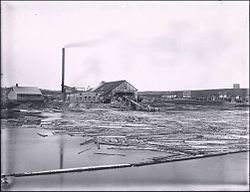Botwood
| Botwood | ||
|---|---|---|
| Town | ||

Exploits River Lumber and Pulp Company
|
||
|
||
| Motto: En Avant (French for "Onward") | ||
| Location of Botwood in Newfoundland | ||
| Coordinates: 49°09′00″N 55°22′00″W / 49.15000°N 55.36667°WCoordinates: 49°09′00″N 55°22′00″W / 49.15000°N 55.36667°W | ||
| Country |
|
|
| Province |
|
|
| Census division | 6 | |
| Area | ||
| • Total | 15.05 km2 (5.81 sq mi) | |
| Elevation | 41 m (135 ft) | |
| Population (2006) | ||
| • Total | 3,052 | |
| • Density | 200/km2 (530/sq mi) | |
| Time zone | Newfoundland Time (UTC-3:30) | |
| • Summer (DST) | Newfoundland Daylight (UTC-2:30) | |
| Postal code span | A0H | |
| Area code(s) | 709 | |
| Website | town |
|
Botwood is a town in north-central Newfoundland, Newfoundland and Labrador, Canada in Census Division 6. It is located on the west shore of the Bay of Exploits on a natural deep water harbour used by cargo ships and seaplanes throughout the town's history.
In 1908 construction began on the Botwood Railway, running between Bishop's Falls and Botwood. It was a joint effort between the A.N.D. Company and the A. E. Reed Company of Bishop's Falls. It was to be the transportation link for the export of pulp and paper from the newly built mill at Grand Falls. The railway became operational by the fall of 1909, and the first shipment of paper from the new mill was sent in February 1910. The A.N.D. Company took control of the railway operation in 1910, just a year after the line was completed.
The first aircraft facilities to be established in Botwood was by Newfoundland born Captain Sydney Bennett (1897–1945) and Australian-born Major Sidney Cotton (1894–1969). It became host to many dignitaries and celebrities, some as part of official delegations and others who were stalled there waiting out inclement flying weather. Among those were Charles Lindbergh and his wife Anne Morrow Lindbergh in 1933.
From 1937 to 1945, both Pan Am and the British Overseas Airways Corporation used Botwood as a terminal for their Atlantic Crossings. On June 27, 1939 the Yankee Clipper left Botwood for the first Trans-Atlantic Passenger flight to Foynes, Ireland.
From the outbreak of World War II, 1940–1945, the Royal Canadian Air Force changed Botwood into a patrolling and bombing seaplane base, home to two squadrons of PBY Canso flying boats equipped with torpedoes and depth charges. A large concrete slipway, two hangars, a tarmac and four bunkers were constructed. The Canadian Army was garrisoned in the town, the army built barracks, a water system, and a full-scale military hospital. The army was responsible for the manning of gun batteries at Philip's Head and Wiseman's Cove that protected the entrance to Botwood Harbour with 10" guns, as well as numerous anti-aircraft batteries throughout the community. During the war Botwood was home to approximately 10,000 Canadian and British personnel and had become Canada's most important over-seas base. In 1942 11 United States military personnel died when their Sikorsky VS-44 flying boat, the Excalibur, crashed and sank in the Bay of Exploits shortly after takeoff from Botwood. In 1943 Bob Hope and his troupe were stormbound in Botwood and performed for the RCAF Coastal Command. Both Franklin Delano Roosevelt and Winston Churchill also overnighted in the town.
...
Wikipedia


